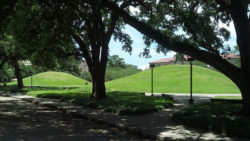Archaic Period
During the Archaic period, people from the Evans culture built large mounds made of dirt.
This entry is 4th Grade level View Full Entry

Wikimedia Commons, SPATMS (photographer)
LSU Indian Mounds.
What was the Archaic period like?
The Archaic period (8000–800 BCE) is the second period that historians and archaeologists use to describe cultures in the United States and Louisiana prior to European colonization.
The Archaic period lasted almost 8000 years! During this time Native people continued to make changes in how they lived in response to major changes in their environment. While modern plants and animals you’d recognize today were present, people still had to adapt to a rapid rise in sea level, which changed the animals and plants that were available to them.
The Archaic period was a time of innovation in technology and society. Different styles of stone points were made by Native peoples of different cultures, who lived in smaller territories than the Paleoindians. These stone points became smaller so that they could be attached to light spears and propelled by throwing sticks known as atlatls. Tools like grinding stones became more common as people learned to eat the nuts, seeds, and grains of new forests. The first fired-earth objects (a kind of clay cooking ball) appeared during this period. The earliest of these were cube-shaped and used for cooking and perhaps for heating stone to make it easier to work into tools.
What different cultures lived in Louisiana during the Archaic period?
During the Archaic period, some cultures created very large mounds made of earth. Louisiana has some of the oldest mounds in North America, including the Louisiana State University Indian Mounds in Baton Rouge and the mounds found at Watson Brake in Ouachita Parish. The Watson Brake site had twelve mounds that were built by a people that archaeologists call the Evans culture. These mounds are large and took a lot of effort and planning to complete. Archaeologists disagree about whether such complicated, long-term construction projects were commanded to be built by some leader or leaders or whether the mounds were built by agreement among the builders.
Using remains recovered from precolonial trash piles called middens, archaeologists can figure out what people ate in the Evans culture. Remains found in middens at Watson Brake contained evidence that fish, mussels, and aquatic snails were a big part of people’s diet. Evidence also shows that they gathered and ate acorn and hickory nuts and grapes.
For unknown reasons, the Evans culture stopped building mounds during the middle of the Archaic period, around 4800 years ago. This break in mound-building lasted almost 1000 years, until a new site called Poverty Point began. At Poverty Point, precolonial peoples in Louisiana took mound building to a whole new level.
